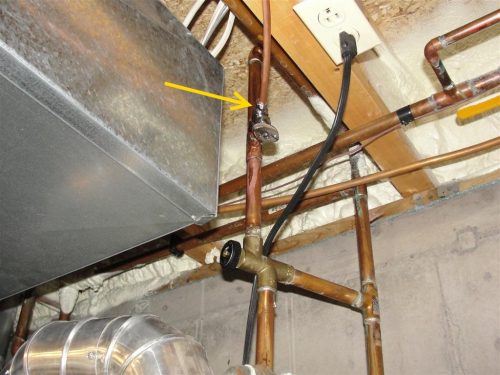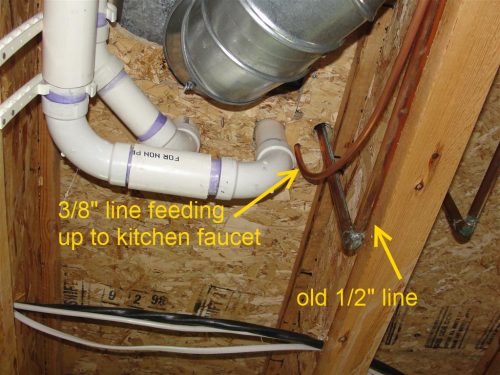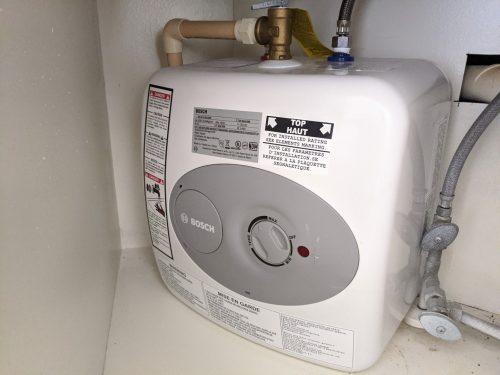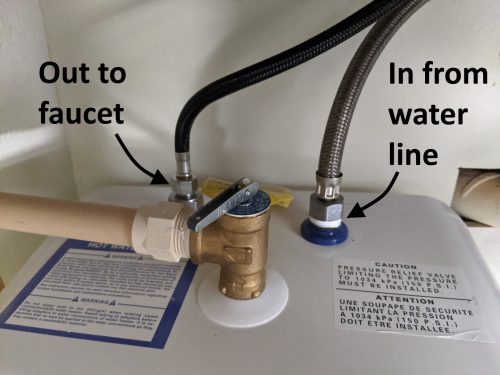Do you get annoyed with how long it takes to get hot water at your kitchen sink faucet? There’s a fix for that. I had problems with this at my last house and my current house, and I fixed the issues at both using different methods. At my last house, it used to take 45 seconds to get hot water my kitchen faucet, and at my new house, well over a minute. Waiting for hot water is like waiting for a web page to load on dial-up internet.
It’s not just about wasted time, however. With a kitchen faucet rated at 2.2 gallons per minute, that equals over 2.2 gallons of wasted water every time I need hot water at the sink. Assuming this happens only ten times per day, this would be over 8,000 gallons of wasted water per year.
Unfinished Basement = smaller water line
My last house had an unfinished basement, which allowed for a fairly elegant repair that cost me less than $40 in materials. I installed a dedicated 3/8″ water supply line from the water piping coming off the top of my water heater to the kitchen sink faucet. By installing this 3/8″ water line, I cut the wait time from 45 seconds down to 10 seconds.
There were two reasons for the dramatic drop in time: first, the water took a straight shot to the kitchen. It used to travel around the stairwell through a 3/4″ line, which meant a lot of room-temperature water had to be purged before the hot water arrived. The other reason this worked so well is that a 3/8″ tube has about a quarter of the volume as a 3/4″ tube.
You might think that this reduction in size would equate to lower water flow at the kitchen faucet, but it actually made no noticeable difference. Hot and cold water flow both seemed to be identical after this switch. So what’s the downside to this, and why don’t more plumbers do this? It’s a code violation. Table 610.3 of the Minnesota State Plumbing Code requires a minimum of 1/2″ pipe to the kitchen sink. Because of this, I left the old 1/2″ water line in place. I figured that if someone made a stink about this when they bought my house, I’d revert to the 1/2″ line and they could start wasting time and water again. That never happened, however. The home inspector for the new buyers never mentioned it, and I say good for him.
Finished Basement = point-of-use water heater
My new (to me) home has a finished basement, so running a 3/8″ water line to the kitchen sink faucet was out of the question. Instead, I installed a point-of-use water heater. I went with the Bosch 2.5-gallon unit which Amazon sells for about $180. After clearing the area under my sink and pre-installing the T&P discharge tube, the installation took me less than five minutes. No joke.
I simply disconnected the hot water supply connector from my kitchen faucet and ran it to the cold inlet on the water heater. I then connected a water supply connector from the outlet on the water heater to the hot water inlet on my faucet. That’s all that was needed for the plumbing portion of the project.
The last part was to plug it in to a traditional 120-volt outlet. This shares the circuit with my dishwasher, and I was a bit worried about nuisance tripping because of that, but it has been a year now and I haven’t had a single trip.
I love this thing; I get hot water after about half a second, and my heart is filled with gratitude every time I turn on my faucet. Even after a year of having this, I still smile and sigh with contentment every time I run hot water. Life is good.
Other methods
Other ways of getting hot water faster are to have a circulation pump added or thermosiphon loop, but I don’t have any firsthand experience installing one of those systems. Talk to your plumber about those, or check out the link above for a detailed explanation of Mr. Buell’s system.






Alan
April 28, 2020, 10:25 am
I had been meaning to look into fixing this issue for some time, so your post was well timed. One question I have: if my dishwasher is connected off of the same line i’m reducing down to 3/8″, will it affect how the dishwasher runs? thanks
Reuben Saltzman
April 28, 2020, 11:30 am
Hi Alan, I suppose it could make for a reduction in flow, but I had the same setup and didn’t notice any difference.
Alan
June 8, 2020, 8:09 am
This is a very late reply, but I went the 3/8″ route to my kitchen sink, and everything went as you described: easy to set up, hot water to the sink went from about 46 to 12 seconds, and the flow didn’t change a bit. Thanks for the recommendation!
Reuben Saltzman
June 8, 2020, 8:18 am
Awesome! Thank you for sharing, Alan. I’m glad it worked.
Ben Franske
April 28, 2020, 7:26 pm
Dishwashers use a float to determine water level so the washer will still fill to the correct level and operate normally. The water inside the dishwasher is recycled for both washing and rinsing I believe. I suppose it could take longer to fill in theory but in practice the line going to the dishwasher itself is probably 3/8 anyway, or going through a 3/8 shutoff. I guess if you were using the sink and starting the dishwasher at the same time you could see a reduction in flow/pressure at both.
Mark
April 28, 2020, 2:59 pm
What did you calculate as the ROI timeline for the under sink water heater? I figure it is costing you about $3.02/month if you use it for 30 minutes per day (1440 watts X .5 hr/day = 21.6 kWh/month X $.14/kWh). Is your hot water heater electric or gas?
Reuben Saltzman
April 28, 2020, 3:02 pm
Hi Mark,
I think you’re pretty close with your estimate of $3/month. But I didn’t make any attempt to calculate an ROI. My main reason for doing this was to get hot water faster; not save on water or energy usage. My main water heater is gas.
Ben Franske
April 28, 2020, 7:23 pm
Why not hook it up to the hot water line instead of the cold water? Then the point of use heater will heat the lukewarm water until the hot water makes it’s way up to the unit. From that point on the unit should remain shut off and just pass the hot water through. Seems like you could have it cost very very little on an ongoing basis by plumbing it that way…
Reuben Saltzman
April 28, 2020, 7:30 pm
Hi Ben, that’s exactly what I did. By the time the point-of-use water heater has run out of its hot water supply, the new water coming in from the water heater is already hot. So it seems to never run out of hot water.
Ben Franske
April 29, 2020, 2:01 pm
Doh, I totally read over the fact it is a 2.5 gallon tank model and not a tankless point of use model. I would think a tankless point of use model would be ultra efficient as it would only ever really draw power for the first minute of usage when it’s active after which it would switch off.